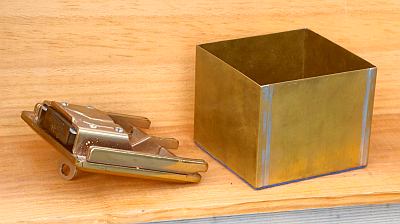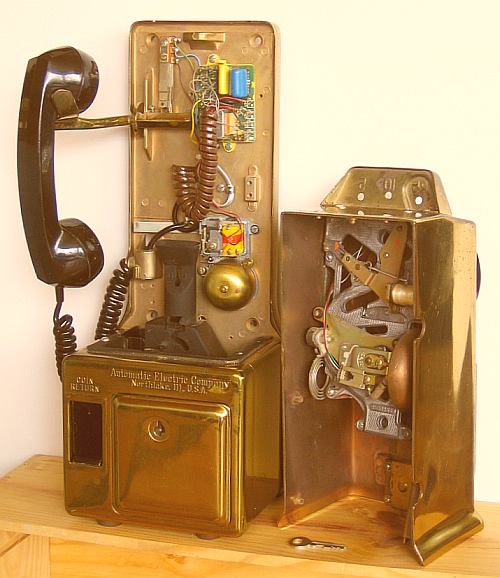I N S I D E THE AUTOMATIC ELECTRIC DIAL P A Y TELEPHONE ...
*******************************************************************
A »SUPER KEY« opens the coin door AND the telephone: For the
COIN DOOR the key has to placed in full into its slot. For opening
the TELEPHONE-LID, the key has to pushed in half until turnable.
REMARK: The brown coil-cord connects the rotary dial in the lid.
The open lid shows the coin shoots and the TWO GONGS - the left
one is a SPIRAL with deep sound, the right a common BELL with
high sound. A QUARTER (25 ¢) hits the spiral. A NICKEL (5 ¢) hits
the bell. A DIME (10 ¢) hits the bell twice. Wrong coins come
back in the RETURN SLOT ...
 ... The missing COIN-BOX is made of brass sheets soldered together.
From Historical Remarks ...
===================================================================
William Gray received a patent on Aug.13, 1889 for a coin operated
device to work the telephone. Later in 1905 Gray developed a pay
station with coin identification that the operator could hear:
Coins inserted in slots fell upon gongs and bells and the distinct
sounds were transmitted with Elisha Gray's "Harmonic Telegraph"
device. If (e.g.) a Quarter Coin was dropped into a SilverDollar
Slot, NO RESONANCE was recognized by the operator. Therefore
every pay station had the instruction:
+-----------------------------------------------------+
| DO NOT DEPOSIT COINS UNTIL OPERATOR ASKS FOR IT |
+-----------------------------------------------------+
Gray founded the GRAY TELEPHONE AND PAY STATION CO. in Hartford,
Connecticut which held a monopoly on the pay station well into the
20th century. 1948 the company was aquired by AUTOMATIC ELECTRIC.
Back to the PAY PHONE Main Page
impressum:
*******************************************************************
© C.HAMANN http://public.BHT-Berlin.de/hamann 11/11/09
... The missing COIN-BOX is made of brass sheets soldered together.
From Historical Remarks ...
===================================================================
William Gray received a patent on Aug.13, 1889 for a coin operated
device to work the telephone. Later in 1905 Gray developed a pay
station with coin identification that the operator could hear:
Coins inserted in slots fell upon gongs and bells and the distinct
sounds were transmitted with Elisha Gray's "Harmonic Telegraph"
device. If (e.g.) a Quarter Coin was dropped into a SilverDollar
Slot, NO RESONANCE was recognized by the operator. Therefore
every pay station had the instruction:
+-----------------------------------------------------+
| DO NOT DEPOSIT COINS UNTIL OPERATOR ASKS FOR IT |
+-----------------------------------------------------+
Gray founded the GRAY TELEPHONE AND PAY STATION CO. in Hartford,
Connecticut which held a monopoly on the pay station well into the
20th century. 1948 the company was aquired by AUTOMATIC ELECTRIC.
Back to the PAY PHONE Main Page
impressum:
*******************************************************************
© C.HAMANN http://public.BHT-Berlin.de/hamann 11/11/09
|

 ... The missing COIN-BOX is made of brass sheets soldered together.
From
... The missing COIN-BOX is made of brass sheets soldered together.
From